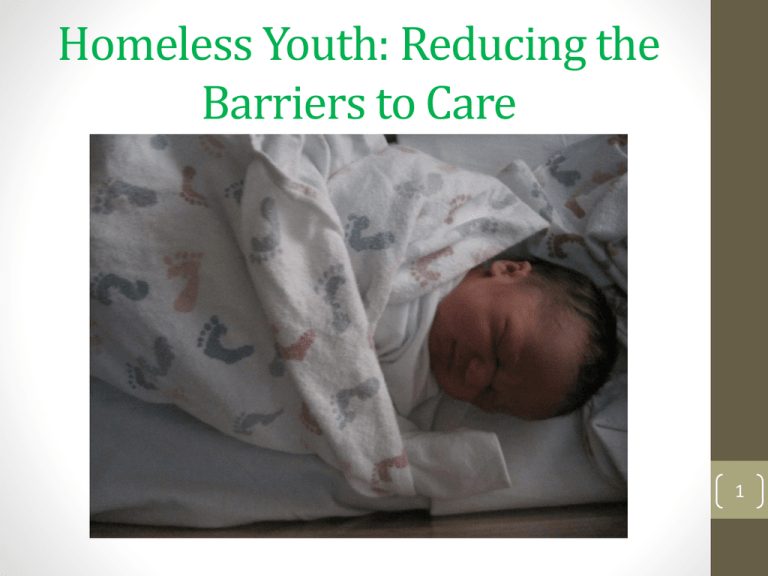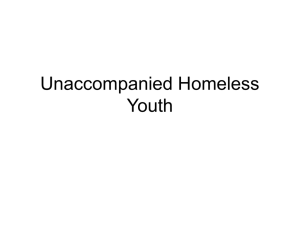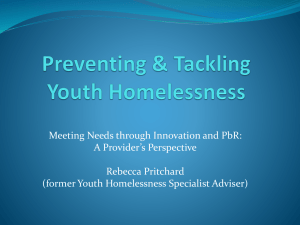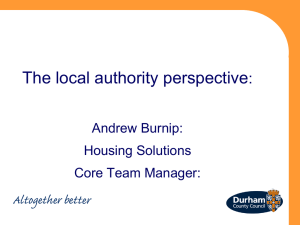
Homeless Youth: Reducing the
Barriers to Care
1
2
3
Homelessness Defined
• The term "homeless children and youths” means individuals who
lack a fixed, regular, and adequate nighttime residence
• This includes children and youths who are
• living in motels, hotels, trailer parks, or camping grounds due
to the lack of alternative adequate accommodations;
• living in cars, parks, public spaces, abandoned buildings,
substandard housing, bus or train stations, similar settings, or
other public or private places not designed for or ordinarily
used as a regular sleeping accommodation for human beings;
• living in emergency or transitional shelters;
• abandoned in hospitals;
• awaiting foster care placement;
• “doubled up” due to loss of housing, economic hardship, or a
similar reason. (DHHS Definition)
4
Prevalence of Youth
Homelessness Nationally
• 5 -7.7% of youth experience homelessness each yr, which means 1.6
million youth between 12-17 yrs and 2.5 million between 16-24.
• Local community programs, funded by the Runaway and Homeless
Youth Act (HHS) and administered by DHHS, served over 786,600
homeless and runaway youth in 2008.
• DHHS reported that 5,100 homeless youth were turned away from
shelter and housing in 2008 due to lack of bed spaces
(Source: National Alliance to End Homelessness)
5
Prevalence of Children & Youth
Homelessness in Maryland
According to the National Center on Family Homelessness:
• Maryland ranks 18th in the Nation in child homelessness(0-18
y.o.)
• In 2010, there were an estimated 12,810 children/youth
experiencing homelessness in Maryland. (This number does
include the 844 homeless, unaccompanied youth)
• Of the 131,000 children/youth living in poverty in Md., one
out of every 10 (10%) are homeless.
6
Prevalence of Youth
Homelessness in Baltimore
• 2007: the Johns Hopkins School of Public Health and the Baltimore
Homeless Youth Initiative conducted a one-day census which
counted 272 homeless and unstably housed young people.
• 2009: the homeless youth count identified 781 young people (ages
10-24) who were homeless or unstably housed. Of these, 426 were
unaccompanied by parents or guardians. (The 2009 number
represents a 287% increase over 2007.)
• In January 2011, the homeless youth count of young people
between the ages of 13 and 25 identified 640 unaccompanied youth
in Baltimore City.
7
Causes of Homelessness
• Lack of livable incomes (i.e., poverty)
• Lack of housing affordable to households with very low
incomes
• Lack of health and supportive services
8
Causes of Homelessness Cont’…
Youth homelessness is largely a reflection of family
breakdown. Youth become homeless for varying reasons,
including:
• leaving home because of physical and/or sexual abuse;
• being abandoned by their parents or guardians – e.g.,
because of non-acceptance of the youth’s gender
identity or sexual orientation; parents incarceration,
parents substance abuse, parents mental health
problems
• being emancipated – e.g., because of teen pregnancy;
• exiting Foster Care and/or the Juvenile Correction
system.
9
Personal Experiences of Youth
Homelessness
•Luther
•Shawn
•Other stories…
“On Our Own” Short Film
http://www.youtube.com/watc
h?v=x1GbfSvJ-5E
10
Realities and Consequences of
Youth Homelessness
Homelessness is bad for one’s health and well-being . It’s
especially dangerous for young people who do not have familial
support. Unaccompanied homeless youth are at a higher risk:
• Physical health problems
• Physical and sexual assault
• Severe emotional stress - including anxiety disorders,
depression, posttraumatic stress disorder (PTSD), and suicide
• Substance abuse
• Prostitution – i.e., “survival sex”: Data indicates that within 72
hours of hitting the streets, 1 out of every 3 runaways will be
forced to engage in survival sex in order to meet their basic
needs for food and shelter (National Runaway Switchboard).
11
Realities and Consequences of
Youth Homelessness, cont’…
• What is it like to be on the street?
Unsafe, scary, and uncomfortable
• Where do youth sleep?
Wherever they feel mostly comfortable and/or safe - it could be a friend’s or family
members house, shelter, bus stop, park bench, alley, etc.
• Where and what do they eat?
They eat whatever they can get their hands on unless health problems only allow
them to eat certain things. Youth go to friends and family houses, soup kitchens or
wherever they feel its safe, comfortable and welcoming to eat.
• What do they look like?
There’s really no way to tell who’s homeless. While some youth might look
distressed in dirty clothes and with poor hygiene, others will be clean and fresh as
anyone who’s housed. you really have to talk and listen to there story. They might
have some holes in there story which could also mean they are homeless.
12
Homeless young people also experience barriers to education and employment.
Homeless Youth have a Right to
an Equal Education
• Homeless youth can:
• Enroll immediately (without records, school uniforms or fees or a
parents involvement)
• Stay at their school of origin even if they are moving from place
to place and receive free transportation to this school, or
• Transfer to the school which is closest to their current location
• Receive free school meals and uniforms
• Access all school activities without paying fees
• Apply for financial aid for college without sharing information
about a parent
13
What do Homeless Youth Want
and Need from Providers?
• Rule #1: Do not “ask are you homeless?”
• Reason: They might not know that they are homeless or they might
be scared or ashamed of it.
• Rule #2: Listen deeply - take the time to process what youth really
are saying.
• Reason: Without really listening it’s easy to miss what youth are
really saying. Also, youth want help and want to know someone
cares and someone is trying to help them.
• Rule #3: Expect that they may not let you in
• Reason: Homeless youth have often been hurt many times and they
haven’t learned that they can trust people.
• Rule #4: Know your boundaries and stick to them
• Reason: Some youth are looking for parents, sisters, aunties, etc. If
you swoop in to help them more than you should, you’re setting
them up to be hurt because you can’t keep that up.
14
Challenges of Serving Youth
Experiencing Homelessness
15
SB 72: The Challenges
• Obtaining Medical Consent. In order to provide routine
primary and preventative health care to minors, a clinician
must receive permission from a parent or legal guardian.
• Access to Care due to perceived cost, lack of trust by youth,
institutional/system barriers, transportation, lack of
knowledge by youth regarding resources in the community.
16
The Solution(s)
•Create a Health Center that
addresses the unique needs
of homeless children/youth
•CHANGE THE LAW
17
Pediatric & Adolescent Clinic at
Health Care for the Homeless, Inc.
18
19
SB 72: The Legal Solution
• The new law allows youth who are living separate from their
parent/guardian and providing self-support to consent to their own
medical treatment.
• This allows unaccompanied youth experiencing homelessness to
seek medical treatment for chronic and acute health conditions such
as asthma, the flu or a sprained ankle.
• The new law also extends liability protections - for lack of parental
consent only - to the clinicians who treat them.
• Providing needed medical care to homeless youth is a critical step
toward ending their homelessness. Given the ability to provide
comprehensive medical care, providers at HCH and elsewhere in the
community now have more tools at their disposal to engage youth
with the hope of helping them treat their health conditions and end
their homelessness.
20
21
22
23
24
SB 72: Lessons Learned
Senate Bill 72 unanimously passed both houses in the Maryland
General Assembly and was signed into law by Governor O’Malley
on May 2. The new law became effective on October 1.
The success demonstrated…
• Importance of Perseverance: It took several years.
• Importance of Legislative Champions: Both Ds and Rs
• Importance of Committed Partners: MedChi, Maryland
Chapter of the American Academy of Pediatrics
• Importance of Provider and Consumer Participation in Policy:
Provides expertise, and puts a face on the real experiences,
challenges and impact
25
The Work Ahead
• Raise awareness about SB72 – and about youth
homelessness generally
• Support the Maryland Unaccompanied Youth Act and other
initiatives to increase services (e.g., youth shelters, more
effective child welfare policies) and reduce barriers for
vulnerable youth
• Advocate for systemic change to address the causes of
homelessness – for people young and old:
• Support living wages and adequate public benefits
• Support the development of housing affordable to households
with extremely low incomes
• Support health care and supportive services for low income
and otherwise vulnerable individuals.
26
Health Care and Housing should
be Fundamental rights
27
Youth Empowered Society
(YES)
• Grew out of the Baltimore Homeless Youth Initiative (BHYI)
• Specifically, the BHYI’s Youth Leaders were the driving force
behind this drop-in center that was planned to be one-stop
shop that was centrally located, easily accessible by public
transportation, open in the evenings, and, most importantly,
staffed by young adults with experiences of homelessness.
• Planning, fundraising, support from OSI, and endless group
decision-making sessions eventually led to YES
• Founded and run by formerly homeless youth and their allies,
the Youth Empowered Society (YES) works to end youth
homelessness in Baltimore by supporting formerly homeless
youth to become leaders in our community and by providing
vital, direct services to homeless youth.
28
YES Drop-In Center
29
YES Drop-In Center
• The YES Drop-In Center is a safe space for youth, who are
homeless or at-risk of homelessness and between ages 14-25,
to get basic needs met and establish supportive relationships
that help them make and sustain connections to long-term
resources and opportunities.
• Our vision is that all Baltimore youth will easily access the
resources they need to achieve stable housing and become
healthy, successful adults.
• The Drop-In Center opened October 3rd and is now open MonThurs 3-8pm to receive youth.
• Currently we provide: clothing, hygiene products, food,
transportation assistance, laundry and storage services,
assistance obtaining identification, appts with providers…
30
The (Few) Other Resources in
Baltimore for Homeless Youth
• Rose Street and Loving Arms Youth Shelters
-8 beds each
• City Steps/AIRS Transitional and Permanent Housing
-7 Transitional beds for single 18-21 year olds
-12 Transitional beds for women with children, 18-24
-43 Permanent housing unites for single 18-24 year olds
-Additional scattered site permanent housing units for
18-24 year olds with disabilities
• Maryland Foster Youth Resource Center
-Resources center and alternative transitional housing
program for transitioning and former foster youth
31
What Else Needs to Exist?
•
•
•
•
•
More shelter beds for youth under 18
A shelter for youth 18-24, with or without children
Shelters that offer therapy services
More one-stop-shop centers like YES
More employment opportunities in fields that youth are
interested in
• More affordable housing
• More permanent supportive housing
• Supportive services to help youth stay housed
32
How Can we Bring About these
Changes?
• The Journey Home for Youth: Updating Baltimore’s 10 Year
Plan to End Homelessness
• Maryland Unaccompanied Homeless Youth Act
• Creates an Office of Unaccompanied Youth Housing within DHCD
charges to provide or contract for:
•
•
•
•
•
Street Outreach Services,
Drop-In Programs,
Youth Shelters and Transitional Living Programs,
Permanent Housing &
Data Collection.
In effect it establishes a right to housing for homeless youth 14-24
• Strategy will likely be to ask for funding for pilot programs first
33
Contact Information
Lisa Stambolis, CPNP
421 Fallsway, Baltimore, MD 21202
443-703-1322
lstambolis@hchmd.org
Lara Law, Shawn Toyer & Luther Thompson
Youth Empowered Society – YES Drop-In Center
2315 N. Charles, 1st Fl, Baltimore, MD 21218
410-235-7744
lara@yesdropincenter.org; shawn@yesdropincenter.org;
thompsonluther88@gmail.com
http://fusionpartnerships.wordpress.com/sponsoredprojects/yes/
34
No Relevant Financial Relationships with Commercial Interests









